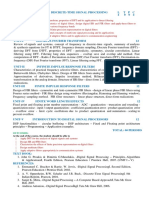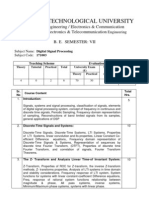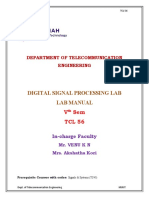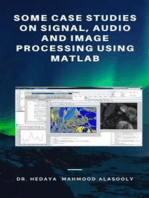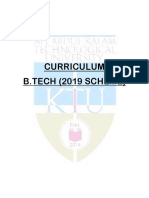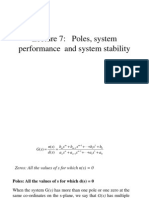0 ratings0% found this document useful (0 votes)
92 viewsDigital Signal Processing S5 Syllabus
This document outlines a Digital Signal Processing course offered in 2015. The course covers concepts like the discrete Fourier transform, fast Fourier transform, and discrete cosine transform. It examines algorithms for efficiently computing the DFT and covers design and realization of IIR and FIR filters. Other topics include multirate signal conversion, finite word length effects, and digital signal processor architecture. The expected outcome is for students to understand digital signal processing principles and applications in electronics engineering. The course is divided into 6 modules taught over 15 weeks, with internal exams and a final exam testing both theoretical and practical concepts.
Uploaded by
Shanavaz ThampykunjuCopyright
© © All Rights Reserved
Available Formats
Download as PDF, TXT or read online on Scribd
0 ratings0% found this document useful (0 votes)
92 viewsDigital Signal Processing S5 Syllabus
This document outlines a Digital Signal Processing course offered in 2015. The course covers concepts like the discrete Fourier transform, fast Fourier transform, and discrete cosine transform. It examines algorithms for efficiently computing the DFT and covers design and realization of IIR and FIR filters. Other topics include multirate signal conversion, finite word length effects, and digital signal processor architecture. The expected outcome is for students to understand digital signal processing principles and applications in electronics engineering. The course is divided into 6 modules taught over 15 weeks, with internal exams and a final exam testing both theoretical and practical concepts.
Uploaded by
Shanavaz ThampykunjuCopyright
© © All Rights Reserved
Available Formats
Download as PDF, TXT or read online on Scribd
You are on page 1/ 3
COURSE L-T-P-
CODE COURSE NAME C YEAR OF INTRODUCTION
EC 301 Digital Signal Processing 3-1-0-4 2015
Prerequisite: EC 202 Signals & Systems,
Course objectives:
The course shall provide:
1. Concepts of Discrete Fourier Transform, Fast Fourier Transform & Discrete Cosine
Transforms
2. Understanding about the development of algorithms for efficient computation of DFT
3. Details about the concepts of design of IIR and FIR filters.
4. Understanding of the realization of various structures for IIR and FIR Filters.
5. Practical consideration about sampling, multirate conversion and its applications
6. Concepts of quantisation effects in digital implementation of IIR and FIR systems.
7. Introduction of the architecture of DSP processors
Syllabus:
DFT, DCT, FFT algorithm, Design of FIR and IIR filters, Realization structures for FIR
and IIR filters, Introduction to digital signal processors, Multirate signal processing, Finite
word length effects in DSP systems
Expected outcome:
After the course, the student will understand the principle of digital signal processing and
applications. The utilization of DSP to electronics engineering will also studied.
Text Books:
1. Proakis J. G. and Manolakis D. G., Digital Signal Processing, 4/e, Pearson Education,
2007.
2. Mitra S. K., Digital Signal Processing: A Computer Based Approach, 4/e McGraw
Hill(India), 2013.
3. Ifeachor E.C. and Jervis B. W., Digital Signal Processing: A Practical Approach, 2/e,
Pearson Education, 2009.
References
1. Oppenheim A. V., Schafer R. W. and Buck J. R., Discrete Time Signal Processing,
3/e, Prentice Hall, 2007.
2. Singh A., and Srinivasan S., Digital Signal Processing: Imlementation Using DSP
Microprocessors, Cenage Learning, 2012.
3. Salivahanan, Digital Signal Processing,2e, Mc Graw –Hill Education New
Delhi,2009
4. NagoorKani,Digital Signal Processing,1e, Mc Graw –Hill Education New Delhi,2010
5. Vaidyanathan P. P., Multirate Systems and Filter Banks, Pearson Education, 2008.
6. Tan L., and Jiang J., Digital Signal Processing, 2/e, Elsevier, 2013.
7. 5. Kumar A. A., Digital Signal Processing, 2/e, Prentice Hall, 2012
Course Plan
Module Course content Sem. Exam
Hours
Marks
The Discrete Fourier Transform: DFT as a linear
transformation, Relationship of the DFT to other 1
transforms
I Properties of DFT and examples 2 15
Linear Filtering methods based on the DFT 2
Frequency Analysis of Signals using the DFT 1
The Discrete Cosine Transform: Forward DCT, Inverse
2
DCT and DCTY as an Orthogonal Transform
Computation of DFT: Radix-2 FFT Algorithms 2
IDFT computation using Radix-2 FFT Algorithms 1
DFT Computation using Radix-4 FFT Algorithms 2
II 15
DFT Computation Using Split-Radix FFT Algorithms 2
Efficient computation of DFT of Two Real Sequences
1
and a 2N-Point Real Sequence
FIRST INTERNAL EXAM
Design of FIR Filters- Symmetric and Anti-symmetric 1
FIR Filters
Design of linear phase FIR Filters using Window
3
method
III Design of linear phase FIR Filters using Window 15
2
method and Frequency Sampling Method
Design of Hilbert Transformers, Comparison of Design
2
Methods for Linear Phase FIR Filters
Characteristics of Commonly Used Analog Filters 1
Design of Analog Butterworth Low Pass Filters 2
IV IIR Digital Filters from Analog Filters (Butterworth) by 15
3
Impulse Invariance and Bilinear Transformation,
Frequency Transformations in the Analog Domain 2
SECOND INTERNAL EXAM
Block diagram and signal flow graph representations 1
FIR Filter Structures: Direct Form, Cascade Form and
2
Lattice Structure
IIR Filter Structures: Direct Form, Transposed Form, 2
V Cascade Form and Parallel Form 20
Computational Complexity of Digital filter structures 1
Digital Signal Processors: Computer architecture for
signal processing, General purpose and special purpose 2
DSP hardware, Architectural description of
TMS320C5545 fixed point digital signal processor
Multi-rate Digital Signal Processing: Decimation and
Interpolation (Time domain and Frequency Domain
2
Interpretation), Sampling Rate Conversion by non-
integer factors
Application examples: High quality analog-to-digital
conversion for digital audio and multirate narrowband 1
digital filtering.
VI 20
Analysis of finite word length effects in DSP systems:
2
Introduction, fixed-point and floating-point DSP
Finite word
arithmetic, ADC length effectsnoise.
quantization in IIR digital filters:
coefficient quantization errors overflow errors, scaling, 2
product round off errors, limit cycle oscillations.
Finite wordlength effects in FFT algorithms: Round off
errors, overflow errors and scaling 1
END SEMESTER EXAM
Question Paper
The question paper shall consist of three parts. Part A covers I and II module, Part B covers
III and IV module, Part C covers V and VI module. Each part has three questions which may
have maximum four subdivisions. Among the three questions one will be a compulsory
question covering both modules and the remaining from each module, of which one to be
answered. Mark patterns are as per the syllabus with maximum 30 % for theory and 70% for
logical/numerical problems, derivation and proof.
You might also like
- University of Mumbai B.E. Electronics EngineeringNo ratings yetUniversity of Mumbai B.E. Electronics Engineering2 pages
- Gujarat Technological University: W.E.F. AY 2018-19No ratings yetGujarat Technological University: W.E.F. AY 2018-193 pages
- 2EC402CC23 Digital Signal Processing SyllabusNo ratings yet2EC402CC23 Digital Signal Processing Syllabus2 pages
- Principles of Digital Signal Processing - Lesson PLanNo ratings yetPrinciples of Digital Signal Processing - Lesson PLan3 pages
- Gujarat Technological University: W.E.F. AY 2018-19No ratings yetGujarat Technological University: W.E.F. AY 2018-194 pages
- Objectives:: at The End of The Course, The Student Should Be Able ToNo ratings yetObjectives:: at The End of The Course, The Student Should Be Able To2 pages
- Gujarat Technological University: W.E.F. AY 2018-19No ratings yetGujarat Technological University: W.E.F. AY 2018-193 pages
- Discrete Time Signal Processing SyllabusNo ratings yetDiscrete Time Signal Processing Syllabus2 pages
- Ec3492 Digital Signal Processing L T P CNo ratings yetEc3492 Digital Signal Processing L T P C2 pages
- 03.09.2021 EEEB3024 - EEEB363 Course Outline Ver July 2021No ratings yet03.09.2021 EEEB3024 - EEEB363 Course Outline Ver July 202110 pages
- Course Information Sheet: Course Coordinator: Course ObjectivesNo ratings yetCourse Information Sheet: Course Coordinator: Course Objectives2 pages
- Gujarat Technological University: Advance Signal Processing and Estimation Semester: IiNo ratings yetGujarat Technological University: Advance Signal Processing and Estimation Semester: Ii3 pages
- Digital Signal Processing 10EC52: - A Unit - 1100% (1)Digital Signal Processing 10EC52: - A Unit - 1160 pages
- ECE2006 Digital-Signal-Processing ETH 1 AC40No ratings yetECE2006 Digital-Signal-Processing ETH 1 AC402 pages
- Non-Linearities in Passive RFID Systems: Third Harmonic Concept and ApplicationsFrom EverandNon-Linearities in Passive RFID Systems: Third Harmonic Concept and ApplicationsNo ratings yet
- Some Case Studies on Signal, Audio and Image Processing Using MatlabFrom EverandSome Case Studies on Signal, Audio and Image Processing Using MatlabNo ratings yet
- Multimedia Signal Processing: Theory and Applications in Speech, Music and CommunicationsFrom EverandMultimedia Signal Processing: Theory and Applications in Speech, Music and CommunicationsNo ratings yet
- Digital Signal Processing Techniques and Applications in Radar Image ProcessingFrom EverandDigital Signal Processing Techniques and Applications in Radar Image ProcessingNo ratings yet
- EC 301 Digital Signal Processing: SyllabusNo ratings yetEC 301 Digital Signal Processing: Syllabus6 pages
- The Annual Quality Assurance Report (AQAR) of The IQACNo ratings yetThe Annual Quality Assurance Report (AQAR) of The IQAC9 pages
- Sheniblog-Islamic-History-Plus-One-Unit2-Arabia The Cradle of IslamNo ratings yetSheniblog-Islamic-History-Plus-One-Unit2-Arabia The Cradle of Islam7 pages
- B Tech 1503 Digital Singal Processing 2008 SCH s6 May 2012No ratings yetB Tech 1503 Digital Singal Processing 2008 SCH s6 May 20123 pages
- Linear and Quadratic Programming ExamplesNo ratings yetLinear and Quadratic Programming Examples14 pages
- Simplex Method (Minimization Example) : Object FunctionNo ratings yetSimplex Method (Minimization Example) : Object Function6 pages
- State Space Representation of Transfer Function SystemsNo ratings yetState Space Representation of Transfer Function Systems5 pages
- CS6018 - Image Processing Module 5 NotesNo ratings yetCS6018 - Image Processing Module 5 Notes15 pages
- Lesson Test For Optimal Solution To A Transportation ProblemNo ratings yetLesson Test For Optimal Solution To A Transportation Problem10 pages
- UT Dallas Syllabus For cs6363.003.07s Taught by Ramaswamy Chandrasekaran (Chandra)No ratings yetUT Dallas Syllabus For cs6363.003.07s Taught by Ramaswamy Chandrasekaran (Chandra)2 pages
- Solving Optimal Power Flow With Voltage Constraints Using Matlab Optimization Toolbox50% (2)Solving Optimal Power Flow With Voltage Constraints Using Matlab Optimization Toolbox55 pages
- Numerical Programming I (For CSE) : Final ExamNo ratings yetNumerical Programming I (For CSE) : Final Exam7 pages
- Control Lecture 8 Poles Performance and Stability100% (1)Control Lecture 8 Poles Performance and Stability20 pages
- j2020 A Survey of The Usages of Deep Learning For Natural Language ProcessingNo ratings yetj2020 A Survey of The Usages of Deep Learning For Natural Language Processing21 pages
- Decimal Place Rounding: Name: Class: DateNo ratings yetDecimal Place Rounding: Name: Class: Date4 pages
- Chapter 2. Representation of Signals and SystemsNo ratings yetChapter 2. Representation of Signals and Systems44 pages
- CS 4700: Foundations of Artificial IntelligenceNo ratings yetCS 4700: Foundations of Artificial Intelligence36 pages
- Introduction To Algorithms: A Creative Approach0% (6)Introduction To Algorithms: A Creative Approach7 pages
- Deep Learning I. Introduction (: 1. The History and The Development of Deep LearningNo ratings yetDeep Learning I. Introduction (: 1. The History and The Development of Deep Learning21 pages















